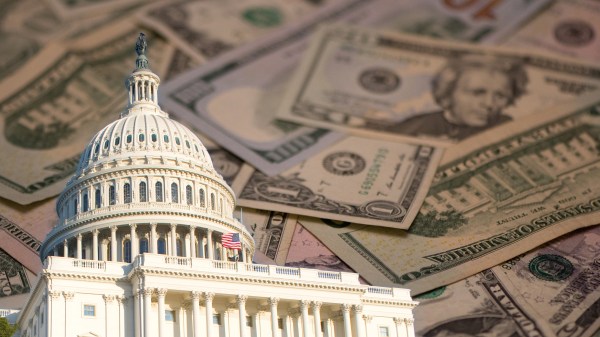Donald Trump and Kamala Harris—whose stints as president and vice president saw a cumulative $12 trillion in deficit-expanding legislation enacted—are competing to see who best can pander to voters with even more expensive spending hikes and tax cuts. Regardless of which one wins the presidency, Panderfest 2024 will likely be followed by annual budget deficits surging toward $4 trillion within a decade.
What would it actually take to cut the budget deficit and stabilize the national debt? The solutions aren’t anything a politician would want to tout on the campaign trail, because they are painful for everyone. A comprehensive plan will involve some changes to our existing entitlement programs and higher taxes for most Americans.
Washington’s fiscal challenge is even worse than commonly understood. Simply continuing current tax and spending policies would push annual budget deficits to nearly $4 trillion a decade from now, or 9 percent of GDP. The national debt held by the public—which has already jumped from 40 percent to 100 percent of GDP since 2008—is projected to soar further to 236 percent of the economy (or $200 trillion) within three decades. Even if the financial markets have the capacity to lend Washington $200 trillion at plausible interest rates (I’m skeptical), the annual interest costs alone would consume between half and three-quarters of all federal taxes by 2054. And this is the rosy budget scenario that assumes no additional spending expansions, tax cuts, natural disasters, wars, or interest rate increases.
The main debt driver is no mystery to budget experts. The retirement of 74 million baby boomers plus rising health care costs will force Social Security and Medicare to run an annual cash shortfall of $650 billion this year that rises to $2.2 trillion a decade from now (yes, these programs can and do run deficits). Over three decades, Social Security and Medicare face a total projected cash shortfall of $124 trillion. These Social Security and Medicare shortfalls drive nearly all projected deficit increases, as the rest of the budget is projected to benefit from rising tax revenues and falling spending as a share of the economy.
Unfortunately, the intense popularity of these two programs leads both parties to propose fake gimmicks to stabilize the debt without touching them. The classic Republican targets of foreign aid and Ukraine funding are barely a rounding error in the long-term deficit estimates. Similarly, “waste, fraud, and abuse” is an empty complaint, immigration reduces federal deficits (contrary to Republican claims), and even eliminating the entire safety net would not balance the long-term budget.
On the Democratic side, taxing millionaires at a 100 percent rate and seizing every penny of billionaire wealth doesn’t get us close to closing our growing fiscal gap. Instead, a tax-based solution would require broadly raising the (combined) payroll tax to 25 percent (from its current 15.3 percent) and imposing a 10 percent value-added tax (essentially a national sales tax). As for liberals’ other favorite target, slashing the defense budget down to the 2 percent of GDP minimum for NATO nations would require laying off most active-duty personnel, while shaving just 1 percent of GDP off a budget deficit eventually heading toward 14 percent of GDP.
So let’s ditch the gimmicks, fake solutions, and liberal and conservative fantasyland proposals. I have a new report out that ditches the gimmicks in favor of a comprehensive, specific, fully scored, 30-year blueprint to stabilize the debt at the current level of 100 percent of GDP. (Sorry, fully balancing the budget is both virtually impossible and not necessary.) It puts all savings options on the table—including aggressively paring back Social Security and Medicare’s $124 trillion cash shortfall. That is the unforgiving mathematical reality—and any politician or interest group that says otherwise is lying to you.
Collectively, these proposals would, in turn, save taxpayers $47 trillion over three decades in reduced interest costs on the federal debt.
This plan also tries to respect both liberal and conservative red lines to the extent feasible while still meeting these extraordinarily difficult savings targets. Thus, Democrats get low-income families protected from significant benefit cuts, higher Social Security minimum benefits, domestic discretionary spending at plausible levels, defense spending falling as a share of GDP, and notable tax hikes, particularly on high earners. The blueprint’s tax hikes exceed its spending cuts through 2036, because the latter always take longer to ramp up.
Republicans get a more market-based Medicare system, caps on per-beneficiary federal Medicaid spending, Social Security reforms focused on the benefit side, and limits on all other spending. Broad-based statutory tax rate increases are so small as to barely be noticed, and other taxes fit conservative frameworks. By the time all deficit reduction savings are ramped up, 60 percent are on the spending side versus 40 percent from new taxes.
First, Social Security: Under my plan, the eligibility age would rise to 69 by 2037. Low-income seniors would receive a higher minimum benefit, while new retirees of middle-and-upper incomes would see their annual benefits set in the neighborhood of $24,000, growing with inflation over time. To cushion the blow, Social Security payroll taxes would end at age 62.
Instead of paying health-care providers directly, Medicare would cover premiums for private health plans offering a benefit at least as generous as the current Medicare system. Seniors who want more expensive health plans would pay the extra cost out of pocket, while those choosing plans that are less expensive (but still at least as generous as the current system) would receive a rebate. The Congressional Budget Office estimates that—as insurers compete for your business—the costs to both seniors and the government would drop by 7 percent without reducing benefits. Additionally, Medicare Part B and D premiums—which cover just one-quarter of the cost of the typical senior’s benefits—would be significantly raised for higher-earning seniors.
As for other spending programs, a reformed Medicaid system would provide states with a set per-enrollee federal subsidy that grows by 3.5 percent annually for children and able-bodied adult enrollees, and 4 percent annually for aged and disabled enrollees. My plan details reforms for farm subsidies, student loans, and pension policies. Discretionary spending—both defense and nondefense—gets capped at 3.5 percent annual growth for three decades.
On the tax side, high earners would pay more. The top tax bracket returns to the pre-2017 level of 39.6 percent, taxpayers in higher brackets would lose some of the value of their itemized tax deductions, and the 20 percent tax deduction for (non-corporate) business income would be repealed. Investments would no longer permanently escape capital gains taxation if held until death and passed down to descendants. Corporations would lose some tax deductions, and the plan repeals President Joe Biden’s expensive tax giveaways to the energy sector. The IRS would be fully funded to collect unpaid taxes.
Both parties will require the political cover that comes from holding hands and jumping together.
Some broad-based taxes must also rise. The tax exclusion for employer-provided health insurance would be capped at 50 percent of the average premium. The Medicare payroll tax would rise by 1 percent (combined). The gas tax would rise by 15 cents per gallon, while a modest new carbon tax would be rebated back to all but the highest-earning one-quarter of families.
Collectively, these proposals would, in turn, save taxpayers $47 trillion over three decades in reduced interest costs on the federal debt.
Yes, this blueprint has something for everyone to hate. Everyone’s ox gets gored. The reforms are painful, yet less so than the alternative savings—such as eliminating the entire safety net (including veterans’ benefits), gutting Social Security and Medicare for low-income seniors, eliminating the defense budget, and/or doubling taxes for the middle class. And, no, faster economic growth—while helpful—would not significantly reduce these projected budget shortfalls.
This plan’s bipartisan compromises are necessary because neither party is strong enough to survive the furious voter backlash that would follow an attempt to raise taxes or cut spending by trillions of dollars annually in a hyperpartisan manner. Both parties will require the political cover that comes from holding hands and jumping together.
Politicians decry the deficit, but don’t trust their voters enough to show them what it would truly take to stabilize the debt. They might not like proposals like my detailed debt-stabilization blueprint, but if they want to complain, they can produce their own fully scored, gimmick-free alternative. Because the math always wins, and continuing Washington’s drive toward an inevitable debt crisis will only make the required savings even more drastic and painful.






Please note that we at The Dispatch hold ourselves, our work, and our commenters to a higher standard than other places on the internet. We welcome comments that foster genuine debate or discussion—including comments critical of us or our work—but responses that include ad hominem attacks on fellow Dispatch members or are intended to stoke fear and anger may be moderated.
With your membership, you only have the ability to comment on The Morning Dispatch articles. Consider upgrading to join the conversation everywhere.